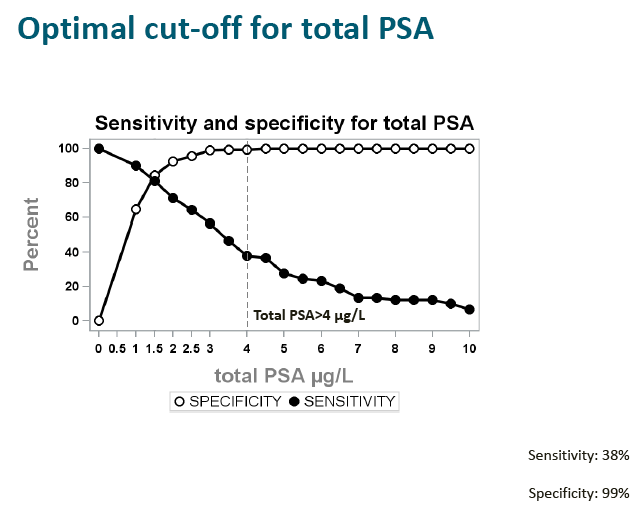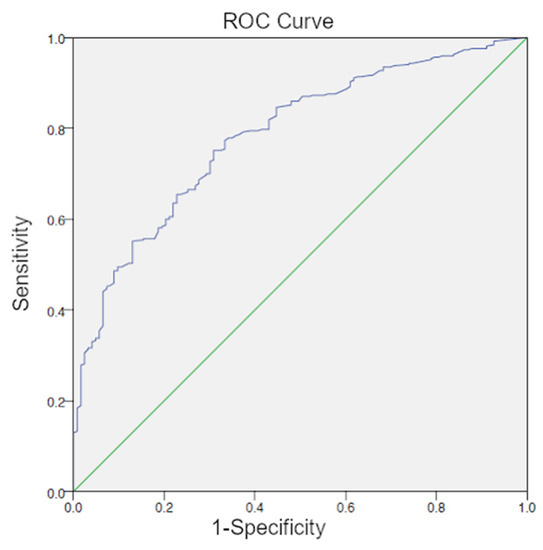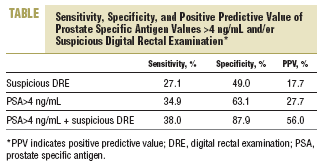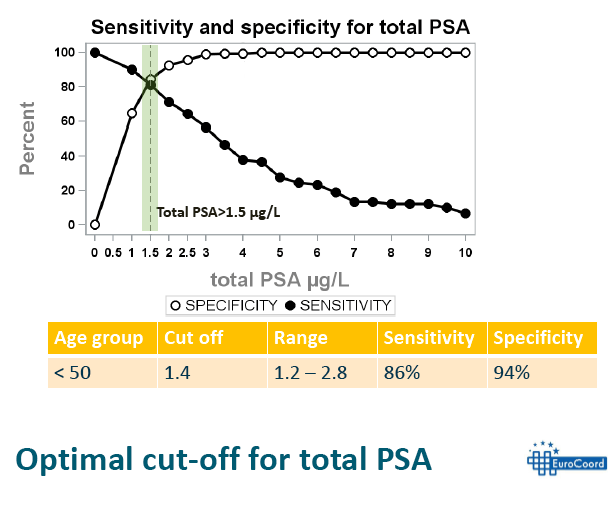Your Psa screening sensitivity and specificity images are available. Psa screening sensitivity and specificity are a topic that is being searched for and liked by netizens today. You can Download the Psa screening sensitivity and specificity files here. Find and Download all royalty-free images.
If you’re looking for psa screening sensitivity and specificity pictures information connected with to the psa screening sensitivity and specificity keyword, you have pay a visit to the right blog. Our site frequently gives you suggestions for downloading the highest quality video and picture content, please kindly surf and find more enlightening video content and images that match your interests.
Psa Screening Sensitivity And Specificity. The specificity at this cut-off is high 936 meaning only 62 of men who do not have prostate cancer falsely test positive. Roles for tumor markers Determine risk PSA Screen for early cancer calcitonin occult blood Diagnose a type of cancer hCG. Lowering the PSA cutpoint to 2 ngml resulted in a sensitivity of 95 a specificity of 20 and an LR of 119. Age-specific reference ranges improved specificity in older men 49 but decreased sensitivity 70 with an LR of 138.
 View Image From njbcs.net
View Image From njbcs.net
The specificity of PSA in the detection of prostate carcinoma was 932 with a range of 631 to 1000. Rather its first use. PC screening using the PSA SPOT test PC screening using the PSA SPOT test kit was offered to male participants in educational public lectures that we conducted in various cities from June 2005 to July 2016. One meta-analysis estimated that the psa test has a sensitivity of 721 percent and a specificity of 932 percent for prostate cancer. The specificity at this cut-off is high 936 meaning only 62 of men who do not have prostate cancer falsely test positive. The Prostate Specific Antigen PSA is one example.
Lowering the PSA cutpoint to 2 ngml resulted in a sensitivity of 95 a specificity of 20 and an LR of 119.
Sensitivity specificity and likelihood ratios can be calculated only when case status is known for all participants in a study. Sensitivity specificity and likelihood ratios can be calculated only when case status is known for all participants in a study. Prostate-specific antigen PSA is a commonly used test to detect prostate cancer. One meta-analysis estimated that the psa test has a sensitivity of 721 percent and a specificity of 932 percent for prostate cancer. Predictive value of PSA was 206 for pts with PSA from 4 to 10 and 327 for those with PSA from 10 to 20 ngml. Specificity for a single type of cancer High sensitivity and specificity for cancerous growth Correlation of marker level with tumor size Homogeneous ie minimal post -translational modifications Short half-life in circulation.
 Source: natap.org
Source: natap.org
Lowering the PSA threshold for screening increases detection of. With this cut-off only 205 of the prostate cancer cases test positive-nearly 80 of prostate cancer cases are missed. Prostate-specific antigen PSA is a commonly used test to detect prostate cancer. Lowering the PSA cutpoint to 2 ngml resulted in a sensitivity of 95 a specificity of 20 and an LR of 119. Predictive value of PSA was 206 for pts with PSA from 4 to 10 and 327 for those with PSA from 10 to 20 ngml.
 Source: researchgate.net
Source: researchgate.net
Sensitivity specificity positive and negative predictive values for different cut offs of PSA 4 10 and 20 was performed. 8 using a biopsy threshold of more than 40. The probability of not having prostate cancer among men with a negative PSA test was 81. Studies are still under way to determine definitively whether PSA screening makes any real difference in the detection of this disease and subsequent patient survival. Answer to Question on Down Syndrome on page 9 Standard Test Sensitivity 55 100 Specificity 18351904 964 Positive Predictive Value 574 68 DNA Sequencing.
 Source: semanticscholar.org
Source: semanticscholar.org
Although the PSA test and DRE combined show an increase in specificity the combined sensitivity value remain drastically lower than serum proteomics. Additionally in the Prostate Cancer Prevention Trial the negative predictive value for a PSA 40 ngml was 81 2. The sensitivity of PSA in detecting prostate carcinoma was 721 with a range of 667 to 1000. Rather its first use. For prostate cancer the standard PSA cut-off of 4 ngmL has low sensitivity.
 Source: researchgate.net
Source: researchgate.net
The PSA assay has been demonstrated to have a superior sensitivity specificity and positive predictive value compared to digital rectal exam2 However serum PSA testing has important limitations and it remains unclear whether any benefits of screening outweigh its harms3 PSA testing was not initially envisioned as a screening strategy. The sensitivity and specificity of the PSA SPOT test were determined using the cut-off value of 40 ngmL. As a baseline test serum PSA screening with a cutoff of 40 ngml has a sensitivity of 21 and specificity of 91. Answer to Question on Down Syndrome on page 9 Standard Test Sensitivity 55 100 Specificity 18351904 964 Positive Predictive Value 574 68 DNA Sequencing. Additionally in the Prostate Cancer Prevention Trial the negative predictive value for a PSA 40 ngml was 81 2.
 Source: researchgate.net
Source: researchgate.net
As a baseline test serum PSA screening with a cutoff of 40 ngml has a sensitivity of 21 and specificity of 91. Race-Specific Normal Ranges Men without cancer from different ethnic and racial groups have different average PSA concentrations. The PSA assay has been demonstrated to have a superior sensitivity specificity and positive predictive value compared to digital rectal exam2 However serum PSA testing has important limitations and it remains unclear whether any benefits of screening outweigh its harms3 PSA testing was not initially envisioned as a screening strategy. Sensitivity specificity and likelihood ratios can be calculated only when case status is known for all participants in a study. PSA levels have been used in screening large populations of men for prostate cancer and have been shown to be useful.
 Source: researchgate.net
Source: researchgate.net
PSA testing was most sensitive 90 but least specific 27 in older men. The sensitivity and specificity of the PSA SPOT test were determined using the cut-off value of 40 ngmL. Sensitivity and specificity are characteristics of. The probability of not having prostate cancer among men with a negative PSA test was 81. For a cut-off of 3 ngml the corresponding figures were sensitivity of 944 and specificity of 894 Table 2.
 Source: brazjurol.com.br
Source: brazjurol.com.br
Specificity for a single type of cancer High sensitivity and specificity for cancerous growth Correlation of marker level with tumor size Homogeneous ie minimal post -translational modifications Short half-life in circulation. Lowering the PSA cutpoint to 2 ngml resulted in a sensitivity of 95 a specificity of 20 and an LR of 119. The probability of not having prostate cancer among men with a negative PSA test was 81. The PSA assay has been demonstrated to have a superior sensitivity specificity and positive predictive value compared to digital rectal exam2 However serum PSA testing has important limitations and it remains unclear whether any benefits of screening outweigh its harms3 PSA testing was not initially envisioned as a screening strategy. Roles for tumor markers Determine risk PSA Screen for early cancer calcitonin occult blood Diagnose a type of cancer hCG.
 Source: researchgate.net
Source: researchgate.net
Although the PSA test and DRE combined show an increase in specificity the combined sensitivity value remain drastically lower than serum proteomics. Figure 1 shows that the AUC of the PSA test was 959 95 confidence interval. Studies are still under way to determine definitively whether PSA screening makes any real difference in the detection of this disease and subsequent patient survival. For prostate cancer the standard PSA cut-off of 4 ngmL has low sensitivity. Additionally in the Prostate Cancer Prevention Trial the negative predictive value for a PSA 40 ngml was 81 2.
 Source: mdpi.com
Source: mdpi.com
For prostate cancer the standard PSA cut-off of 4 ngmL has low sensitivity. Studies are still under way to determine definitively whether PSA screening makes any real difference in the detection of this disease and subsequent patient survival. Lowering the PSA threshold for screening increases detection of. Figure 1 shows that the AUC of the PSA test was 959 95 confidence interval. The data on positive predictive value sensitivity and specificity of DRE are shown in Table 3.
 Source: njbcs.net
Source: njbcs.net
The data on positive predictive value sensitivity and specificity of DRE are shown in Table 3. Age-specific reference ranges improved specificity in older men 49 but decreased sensitivity 70 with an LR of 138. Rather its first use. Attention has mostly focused on the use of PSA in screening asymptomatic patients but the diagnostic accuracy of PSA for prostate cancer in patients with symptoms is less well understood. Although the PSA test and DRE combined show an increase in specificity the combined sensitivity value remain drastically lower than serum proteomics.
 Source: researchgate.net
Source: researchgate.net
Additionally in the Prostate Cancer Prevention Trial the negative predictive value for a PSA 40 ngml was 81 2. Age-specific reference ranges improved specificity in older men 49 but decreased sensitivity 70 with an LR of 138. Predictive value of PSA was 206 for pts with PSA from 4 to 10 and 327 for those with PSA from 10 to 20 ngml. PC screening using the PSA SPOT test PC screening using the PSA SPOT test kit was offered to male participants in educational public lectures that we conducted in various cities from June 2005 to July 2016. Lowering the threshold to more than 25 ng per ml 25 μg per l increases the false-positive rate to 80.
 Source: europeanurology.com
Source: europeanurology.com
The specificity of PSA in the detection of prostate carcinoma was 932 with a range of 631 to 1000. The PSA assay has been demonstrated to have a superior sensitivity specificity and positive predictive value compared to digital rectal exam2 However serum PSA testing has important limitations and it remains unclear whether any benefits of screening outweigh its harms3 PSA testing was not initially envisioned as a screening strategy. Prostate-specific antigen PSA is a commonly used test to detect prostate cancer. Sensitivity indicates the capacity to find persons with disease whereas specificity is the ability to identify those free of the target disorder. Lowering the threshold to more than 25 ng per ml 25 μg per l increases the false-positive rate to 80.
 Source: valuehealthregionalissues.com
Source: valuehealthregionalissues.com
Additionally in the Prostate Cancer Prevention Trial the negative predictive value for a PSA 40 ngml was 81 2. However an increase in specificity is associated with a decrease in sensitivity so these tests must be balanced with the concern for missing the diagnosis of potentially significant disease. It is important to know and understand the clinical implications of the sensitivity and specificity of diagnostic tests. For a cut-off of 3 ngml the corresponding figures were sensitivity of 944 and specificity of 894 Table 2. Screening for prostate cancer.
 Source: elsevier.es
Source: elsevier.es
Screening for prostate cancer. 8 using a biopsy threshold of more than 40. A systematic database search was conducted of Medline EMBASE Web of. Lowering the PSA threshold for screening increases detection of. The sensitivity of PSA in detecting prostate carcinoma was 721 with a range of 667 to 1000.
 Source: degruyter.com
Source: degruyter.com
The Prostate Specific Antigen PSA is one example. 8 using a biopsy threshold of more than 40. Sensitivity specificity positive and negative predictive values for different cut offs of PSA 4 10 and 20 was performed. Age-specific reference ranges improved specificity in older men 49 but decreased sensitivity 70 with an LR of 138. Answer to Question on Down Syndrome on page 9 Standard Test Sensitivity 55 100 Specificity 18351904 964 Positive Predictive Value 574 68 DNA Sequencing.
 Source: natap.org
Source: natap.org
Lowering the threshold to more than 25 ng per ml 25 μg per l increases the false-positive rate to 80. Specificity for a single type of cancer High sensitivity and specificity for cancerous growth Correlation of marker level with tumor size Homogeneous ie minimal post -translational modifications Short half-life in circulation. However most urologists would testify that they. Prostate-specific antigen PSA is a commonly used test to detect prostate cancer. The data on positive predictive value sensitivity and specificity of DRE are shown in Table 3.
 Source: health.gov.on.ca
Source: health.gov.on.ca
Sensitivity specificity and likelihood ratios can be calculated only when case status is known for all participants in a study. Increasing the specificity of prostate cancer screening above that of PSA testing should reduce the incidence of unnecessary prostate biopsy. Attention has mostly focused on the use of PSA in screening asymptomatic patients but the diagnostic accuracy of PSA for prostate cancer in patients with symptoms is less well understood. Rather its first use. Studies are still under way to determine definitively whether PSA screening makes any real difference in the detection of this disease and subsequent patient survival.
 Source: slidetodoc.com
Source: slidetodoc.com
PC screening using the PSA SPOT test PC screening using the PSA SPOT test kit was offered to male participants in educational public lectures that we conducted in various cities from June 2005 to July 2016. Sensitivity specificity positive and negative predictive values for different cut offs of PSA 4 10 and 20 was performed. Rather its first use. For a cut-off of 3 ngml the corresponding figures were sensitivity of 944 and specificity of 894 Table 2. This method has been proven to be considerably superior to the PSA test and DRE for prostate cancer screening purposes.
This site is an open community for users to do sharing their favorite wallpapers on the internet, all images or pictures in this website are for personal wallpaper use only, it is stricly prohibited to use this wallpaper for commercial purposes, if you are the author and find this image is shared without your permission, please kindly raise a DMCA report to Us.
If you find this site serviceableness, please support us by sharing this posts to your own social media accounts like Facebook, Instagram and so on or you can also save this blog page with the title psa screening sensitivity and specificity by using Ctrl + D for devices a laptop with a Windows operating system or Command + D for laptops with an Apple operating system. If you use a smartphone, you can also use the drawer menu of the browser you are using. Whether it’s a Windows, Mac, iOS or Android operating system, you will still be able to bookmark this website.






